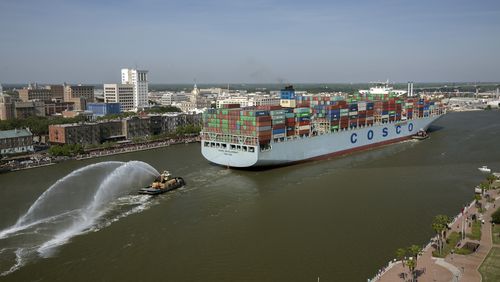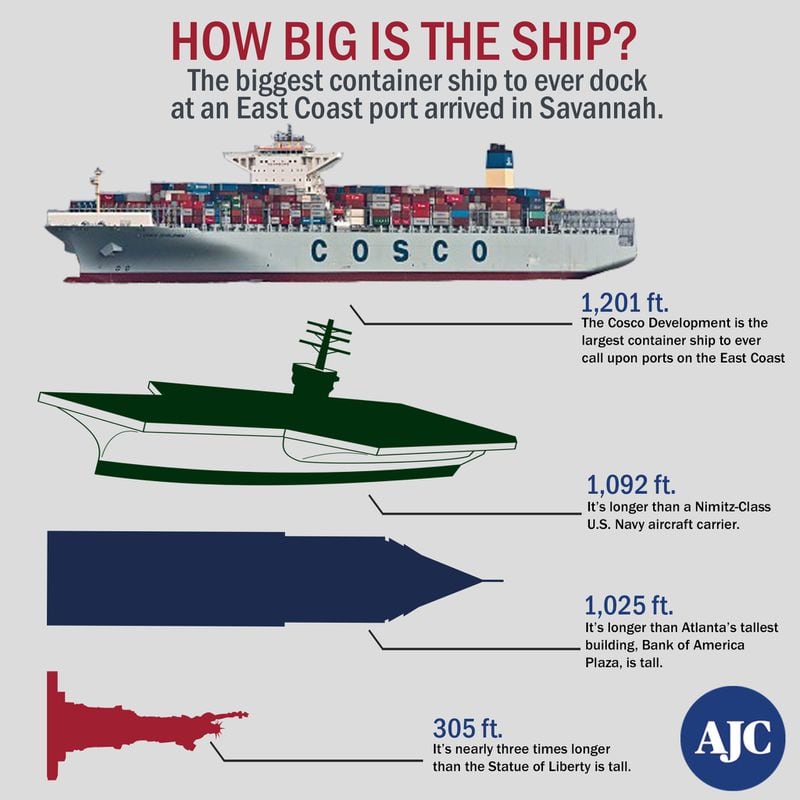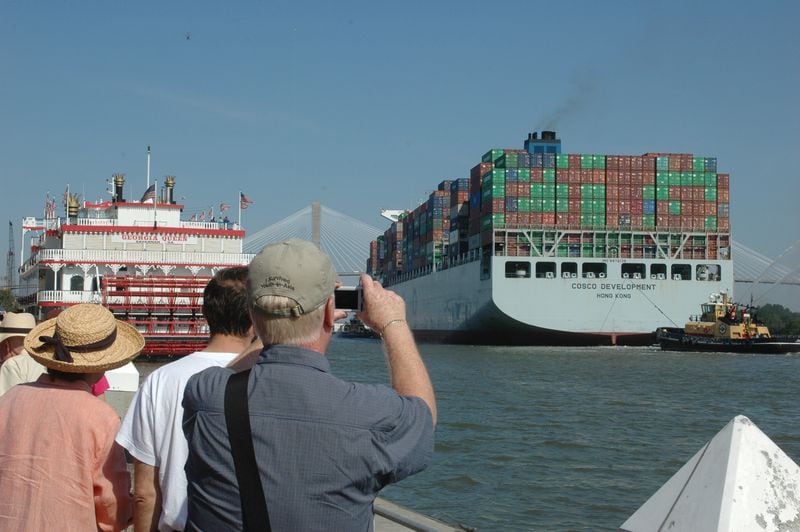SAVANNAH — Frank Haynes comes to River Street along this historic city’s waterfront every chance he can get to watch the cargo ships slowly float in and out of the harbor.
"Near everyday if I'm not at work," said Haynes, who sees the ships as omens of a stronger economy. Thursday's showing didn't disappoint as the Cosco Development, the biggest container ship to ever dock at an East Coast port, arrived in Savannah and squeezed under the Talmadge Memorial Bridge.
And it was just barely under the bridge, which clears the water by about 185 feet, or about 17 stories.
Haynes was among a crowd of hundreds, possibly more, to watch a historic moment for the Savannah port and the state. The hulking vessel, state leaders say, portends waves of bigger ships to come.
An expansion of the Panama Canal to allow larger vessels opened last year, tantalizing state leaders with the prospect of new shipping business to bolster Georgia's position as a leading logistics hub. The race is on, meanwhile, for the long-awaited and costly deepening of the Savannah River to accommodate ever larger freighters amid an arms race for eastern seaboard port supremacy.
On Friday, Gov. Nathan Deal and other dignitaries will gather to welcome the giant ship.
“We have for really 17 years now been building this port up for this moment,” Griff Lynch, executive director of the Georgia Ports Authority, said of the Development’s arrival.
Though Georgia has seen a surge of business at its ports, the shipping business is a fickle industry that rides the waves of an interconnected global economy. The flow of megaships through the Panama Canal hasn't met earlier lofty projections so far.
There is also uncertainty about the Trump administration’s protectionist stance on trade.
The East Coast already has been the beneficiary of a shift in the business from the West Coast, stimulated in part by labor strife at ports there, and it’s unclear just how much more of a boom might come to Georgia from the Panama expansion.
The Savannah River deepening, meanwhile, took a hit last month when the U.S. Army Corps of Engineers estimated its price tag would climb 38 percent to nearly $1 billion and take two years longer to finish because rising dredging costs and other complications.
The port of New York-New Jersey is in the process of raising a key bridge to fit bigger ships, while rival Charleston is also pushing to make its harbor deeper.
The corps, meanwhile, found several years ago “no additional cargo volume” would flow through Savannah because of a deeper river. But given rising port competition and promises of new business the deepening went ahead to help Georgia keep up with the maritime Joneses.
Still, state leaders remain buoyant about Savannah’s prospects.
The Panama Canal expansion allows for larger ships with more containers, shortening the route from Asia by thousands of miles, and making the cost of shipping to the East Coast more competitive than offloading freight in California and shipping east by rail.
Lynch called the cost increase and delay to the dredging project a disappointment. But he said the corps also found the economic benefits to Georgia and the nation will be far greater than initially projected because of substantial cost savings for shippers, which benefits to businesses and consumers.
“You never want to have [costs rise for] any project, but the cost-benefit figures actually improved,” he said.
Metro Atlanta has enjoyed a post-recession investment bonanza in its network of warehouses and trucking terminals. The area's warehousing industry has boomed with tens of millions of square feet of new development and thousands of jobs from companies such as UPS, Amazon and traditional retailers.
“This is not just important for businesses in Savannah, but for businesses across the state,” said Roger Tutterow, a Kennesaw State University economist.
The state and the ports authority have invested hundreds of millions of dollars in infrastructure on land and the dredging program to beef up the port’s capacity.
Georgia’s ports system accounts for some $40 billion in estimated economic impact across the state, and directly or indirectly touch about 400,000 jobs. The Savannah port, the nation’s No. 4 container port by volume, saw its container volume grow by 5.6 percent in March from a year earlier.
Ships such as the Development, which can hold more than 13,000 TEUs or twenty-foot equivalent container units, must traverse the Savannah River at high tide. It also won’t be fully loaded to make it safely through the relatively shallow river channel.
But the dredging underway will allow such super-freighters to navigate more frequently, Lynch said.
That’s what people like Haynes want to hear. The 46-year-old construction worker moved to Savannah about a year ago. He tracked the ship’s approach on his phone Thursday morning before it appeared above the trees about 9:35 a.m.
“They’re going to bring a lot of work,” Haynes said.
Cost and challenges
The push to deepen the Savannah River, however, hasn’t come without controversy. The project was stalled by nearly two decades of bureaucratic delays, environmental hurdles and political wrangling.
But the final agreements for what was then a $706 million project were finally signed in October 2014. Georgia taxpayers ponied up $266 million to get started, and federal funds have come in fits and starts.
The federal government is responsible for 75 percent of the project, while the state must provide the rest.
With the port project now climbing to $973 million as of the latest estimates, state leaders will likely need to find another $67 million to fund their share of the price hike, while the federal government will have to pay about $200 million more than originally forecast.
Those federal dollars might be a tough fight at a time when President Donald Trump has called for cuts in nondefense spending. But Trump also appears open to public works projects, floating a $1 trillion infrastructure program.
The corps has also had to deal with protests over contract awards, which has contributed to delays.
But that same study also found the economic benefits to the project had grown, meaning the payback to the American economy will come quicker.
Figures released in April by the corps found the project’s return on investment would actually increase, despite the higher project cost, from $5.50 in economic benefits per dollar spent on construction to $7.30.
The corps now projects a net annual benefit to the national economy of $282 million a year, up from $174 million.
Much of that is cost savings for shippers, said Billy Birdwell, a spokesman for the Corps of Engineers’ Savannah office. A deeper port allow bigger, more efficient ships “without tidal delays,” he said.
“The fuel savings alone are immense,” he said.
Ship would ‘cripple’ other ports
Lynch said the port moves about 1,100 to 1,200 containers on and off the average ship that calls on Savannah. But the Development is expected to call for about 5,500 containers to be loaded and off-loaded. That’s a record for Savannah for one ship.
Few ports could handle so many at once, he said.
“The ship we are going to have here Thursday and Friday would cripple some ports,” Lynch said.
MYAJC.COM: REAL JOURNALISM. REAL LOCAL IMPACT.
AJC Business reporter J. Scott Trubey keeps you updated on the latest news about economic development and commercial real estate in metro Atlanta and beyond. You'll find more on myAJC.com, including these stories:
Never miss a minute of what's happening in local business news. Subscribe to myAJC.com.









